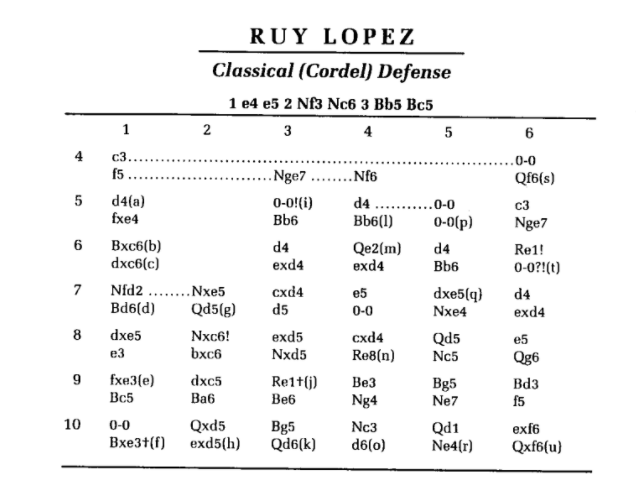
DOES ANYBODY KNOW HOW TO READ THIS FROM THE MODERN CHESS OPENINGS ?
Yes. After 4 c3, there are three main black alternatives. They are 4..f5, 4.. Nge7 and 4 Nf6.
After 4 O-O, 4.. Qf6 is the main move.
Footnote s gives other alternatives.
And so on.
You need the rest of the page to show you the footnotes.
You play the top center moves "1 e4 e5 2 Nf3 Nf6 3 Bb5 Bc5" which gives you the titled opening "Classical (Cordel) Defense".
From there, white can play 4 c3 or 0-0.
If white plays c3, black can play f5, Nge7, or Nf6.
If white plays 0-0, then black can play Qf6.
You then continue to moves 5-10 in the same way. If you see a letter in parenthesis, that means there is a game to look at with that line. You can also notice that Games a and b have the same moves as games c and d. Games a-e have the same moves as game f. Game g is a deviation after game c.
please turn off the caps lock its annoying and a little rude as they say it seems like you are shouting you should use proper capitalization and punctuation my post here is another example of how annoying it is not to do that but at least i didnt shout
There's the columns that follow the sequence of moves at the top. They are the variations. What I am not able to read is the part where they say .................................................... in the line. What does that refer to?
The dotted lines are connecting the alternative moves in the different lines. But I find the dots don't add any information, and I just ignore them.
Can anybody plzz tell me what are these:
± ⁈ ! † += =+ = and the infinity sign
Plzz Help me out guys 🥲
± clear edge for white
⁈ dubious move
! good move
† check
+= slight edge for white
=+ slight edge for black
= equality
infinity sign: unclear position
± clear edge for white
⁈ dubious move
! good move
† check
+= slight edge for white
=+ slight edge for black
= equality
infinity sign: unclear position
Thank you so much ~~ <3
for example: in Nge6 what does "e" stand for in this notion?
Nge6 is actually just saying the knight in the g file goes to e6 square. So g is for you to know better which knight to move or was moved, but it's not a necessary thing, some will just note "Ne6", like chess.com, they'll just note "Ne6". So basically the e is just a regular e, but the g is for not confusing you. Hope this helps ;]